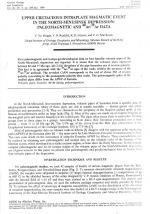Добрый день, Коллеги. Важное сообщение, просьба принять участие. Музей Ферсмана ищет помощь для реставрационных работ в помещении. Подробности по ссылке
Upper cretaceous intraplate magmatic event in the North-Minusinsk depression: paleomagnetic and 40Ar/39Ar data
First paleomagnetic and isotope-geochronological data on four basaltic volcanic pipes of the North-Minusinsk depression are reported. It is shown that the volcanic pipes appeared between 82 and 77 Ma ago. All ChRM directions of the pipe basanites are of reverse polarity. This fact is in agreement with the 40Ar-?9Ar ages of the rocks (within the accuracy of the 40Ar-39Ar method). The revealed ChRM corresponds to the end of chron 33R of reverse polarity (according to the geomagnetic-polarity time scale). The paleomagnetic poles of the studied pipes differ from the APWP of Eurasia.
In the North-Minusinsk intermontane depression, volcanic pipes of basanites form a specific area of alkali-basaltoid volcanism. Many of these pipes are rich in mantle xenoliths - diverse garnet and spinel. peridoLites and pyroxenites [1-3]. They are clustered on the periphery of the Kop'evo arched uplift, at the flexures of northwestern strike on large faults (Fig. 1). Most of the pipes are made up of eruptive breccias in the marginal parts and massive basanites in the central part. The pipes often occur close to each other, lormmg groups (two or three pipes in a group). According to K-Ar dates, their formation proceeded over a long period - from 71 to 28 Ma ago [4]. The U-Pb age of the zircon from the Bele pipe (determined in the Geophysical Laboratory of the Carnegie Institute, US) is 77.9 Ma [2].
Most of paleomagnetic data on volcanic rocks in Siberia [5] disagree with the apparent polar wandering path (APWP) of the Eurasian plate [6] - the main curve for Late Mesozoic-Cenozoic reconstructions in Asia. This casts some doubt on the correctness of using the Eurasian APWP for Siberia. These contradictious can be resolved by obtaining new paleomagnetic and isotope data on the volcanic rocks of the framing с Siberian craton, which developed in a stable tectonic regime, at least since the Early Mesozoic. In this context, complex paleomagnetic and Ar-Ar isotope studies of the volcanic pipes of the North-Minusinsk depression are of great interest. In this paper we present first paleomagnetic and geochronological data on basalts from four volcanic pipes of the depression.
INVESTIGATION TECHNIQUE AND RESULTS
For paleomagnetic studies, we took 42 samples of basalts of various magmatic phases from the Bele. Sestra, Kongarovskaya, and Borazhul'skaya pipes (Fig. 1). To measure characteristic remanent magnetization (ChRM), the samples were subjected to stepwise (17 steps) thermal demagnetization (.t temperatures of up to 690° C) in the shielded furnace of the setup designed by V. P. Aparin (Institute of Physics, Krasnoyarsk) with the internal field of < 10 nT and then were studied on a JR-4 spin-magnetometer. For analysis and presentation of paleomagnetic data, we used the software package compiled and kindly provided by Enkm [7]. To estimate the effect of anisotropy of magnetic susceptibility (AMS) on the distribution of the directions of remanent magnetization, the same samples were also studied on a KLY-2 kappa-bridgc in the Paleomagnetic Laboratory of the East-Siberian Research Institute of Geology, Geophysics and Mineral Resources, Irkutsk.




